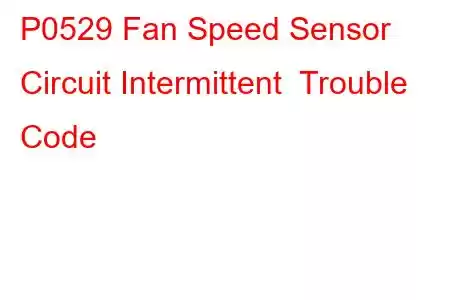P0529 Fan Speed Sensor Circuit Intermittent
OBD-II Trouble Code Technical Description
Fan Speed Sensor Circuit Intermittent
This diagnostic trouble code (DTC) is a generic OBD-II powertrain code. It is considered generic because it applies to all makes and models of vehicles (1996-newer), although specific repair steps may vary depending on the model.
What does that mean?
Some vehicles are equipped with a sensor at the end of the cooling fan that detects movement during vehicle operation. The sensor is used to determine if the fan is running on a fan clutch equipped vehicle, or used to verify fan speed commanded by the Powertrain Control Module (PCM) or Engine Control Module (ECM) matches the actual fan speed detected on an electric fan equipped vehicle.
The sensor used is a 3 wire, hall effect sensor which uses a 5 volt reference source from the PCM, a ground wire and a signal wire to the PCM to determine fan speed. Specifically, a P0529 trouble code means the PCM/ECM is not recieving a steady voltage output from the fan sensor signal wire.
Note: Be careful not to touch an electric fan as it may turn on even when the vehicle is not operating. This code is similar to P0526, P0527 and P0528
Symptoms
Symptoms of a P0529 DTC may include:
Malfunction Indicator Lamp illumination (a.k.a. Check Engine Light) Vehicle may be overheating or running hotter than normalCauses
Potential causes of a P0529 code include:
Loose connection in cooling fan sensor harness or PCM/ECM harness Faulty PCM/ECM Faulty cooling fan speed sensorPossible Solutions
Cooling fan sensor harness - Check for loose connections and damaged wiring that may have come in contact with cooling fan. Unplug cooling fan sensor connector and connector at PCM and check for resistance using a Digital Volt Ohm Meter (DVOM) with leads at each end of the power wire, signal wire and ground (if connected to the PCM/ECM). Some vehicle manufacturers have issued a Technical Service Bulletin (TSB) for replacement of the sensor wiring harness. Replace or repair harness.
PCM/ECM - Disconnect fan speed sensor harness and PCM/ECM harness, using a DVOM with positive and negative leads connected to each end, check for excessive resistance in signal wire circuit. Back probe signal wire using a DVOM set to the volts scale or a graphing multimeter at the sensor harness and the PCM/ECM with the positive lead on the signal wire and negative lead to a known good ground to determine if the voltage is present from the fan speed sensor. If signal voltage is constant and raises with increased fan speed, suspect faulty PCM/ECM.
Cooling Fan Speed Sensor - Check speed sensor mounting on the end of the cooling fan assembly for loose mounting or a loose connector. Disconnect harness connector from sensor and test for continuity using the DVOM set to ohms scale between the power, ground and signal wires, no resistance should be present between the signal wire and either the ground or power wires. If resistance is present while turning fan by hand, there may be an internal short.
The signal wire may only be tested during actual fan operation by back probing the harness connector with the DVOM set to volts scale, or a graphing multimeter with the positive lead on the signal wire and the negative lead to a known good ground, since the hall effect sensor used operates by creating a magnetic field that changes voltage while the fan is spinning. As fan speed increases, the volage should also increase. Replace cooling fan speed sensor if wiring is good and signal voltage occasionally drops.
Read: 50


